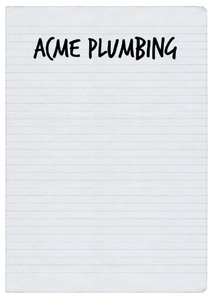
|
| Photo credit: ©istockphoto.com/thumb |
Over the last several months I’ve enjoyed working with some of our nation’s best service and replacement contractors. I’m always honored to serve my clients and very blessed to ride alongside some of the best technicians in the business. Putting on a client’s company uniform and getting in the truck to experience real-time, face-to-face service calls is priceless.
It gives me the ability to witness my workshop skill-building and video-based training in action. I like to observe how the teachings are applied directly with customers in the field, outside of the seminar or meeting room setting.
One of the things I’m very adamant about in my classroom training (and I may differ from some other trainers in this) is the strategy of building an effective presentation for the customer. I teach selling technicians to take a few minutes and get out of the house with the purpose of crafting an Option Sheet in their trucks.
An Option Sheet is exactly what the title implies. It’s a simple sheet of paper that might have a company logo and phone number at the top as well as some blank lines down the page, but it’s an extremely simple document with very little on it by design. The goal of the Option Sheet is to serve as a communication tool between a technician and his customer.
We all know most technicians despise doing paperwork, so it’s critically important to help your team understand the value, function and importance of this simple yet effective little tool. The goal is to facilitate better communication with a customer as the technician is educating her about the choices she has regarding service in her home. It is not a tool designed with the intention of adding even more paperwork to an already overloaded team member.
Proper execution
Some technicians (as well as owners and managers) have a misguided, limiting belief that if they leave the house and go to the truck for five or seven minutes to craft this sheet, they lose the connection with the customer. What? Really? If you lose a connection with your customer because you stepped to your truck for a measly five minutes, then guess what? You never had a great connection with her in the first place!
This is why quality connection questions are so vital early in the call. When technicians ask good quality questions, not only are they forming a connection with their customers, they are setting themselves up to build a better Option Sheet and overall presentation.
When technicians attempt to put together an Option Sheet in front of a customer, a silent sense of unease is felt by the customer. A lot of questions are circulating through her head and anxiety begins to build because there are so many unknowns.
It’s one thing to let a customer know that you will have a few options for her to consider. However, when you sit at her kitchen table, get out your pricing manual and a calculator then start writing in silence, punching a bunch of numbers into a calculator while transferring them to your Options Sheet, a disconnect starts to form. This disconnect is completely unnecessary for both the customer and the technician. It can be avoided by simply going to the truck to create the Option Sheet.
Some technicians argue they are comfortable filling out options in the presence of a customer, but I’ll tell you right now from firsthand experience, time after time the customer becomes uncomfortable regardless of the small talk she might be engaging in with the technician. My service and sales system is all about connecting with a customer and making her as comfortable as possible before, during and after we delve into options and pricing.
Your team must be very thorough and diligent when asking questions to uncover everything that may be going on with the customer’s specific circumstances. Once all the information is obtained through proper questioning, we are now ready to craft a quality Option Sheet.
The technician simply says something along the lines of, “Mrs. Jones, I’ve addressed everything regarding your situation, now I’m going to step out to my truck for a couple minutes and put together some options for you. It should only take five or seven minutes, does that sound OK?” In all the countless ride-alongs I’ve experienced, I have yet to see a customer say anything other than something such as, “Sure, that’ll be fine.”
However, once the technician gets to the truck, it becomes crucial he is efficient with his time and gets right to creating the Option Sheet. This is not the time for phone calls to a spouse or friends; just get down to business. If it takes too long to get this sheet ready, the customer might get agitated wondering what’s taking so long. She may have called only about a quick fix for something, so she is confused about what’s taking so much time to accomplish in the truck.
There are multiple benefits for everyone involved by breaking up the human interaction for a few minutes to build the Option Sheet. It certainly gives the technician a chance to breathe a little bit and get his Option Sheet crafted, as well as think through the presentation he is about to give. He can revisit any notes taken during his communication with the customer and have time to analyze what the best solution is for that specific situation.
Creating this intentional break in interaction also affords the customer a moment to take a breath since there’s a good chance the technician will be covering more options than the customer might have originally anticipated. Trust me, if a good connection was formed between the technician and customer, a few minutes apart will be a positive opportunity, not a detriment.
Everyone wins when Option Sheets are involved and everyone is much more comfortable in the process. The technician is able to better organize his findings and the customer appreciates having several choices. Additionally, building the Option Sheet in the truck allows both the customer and technician a moment to prepare for the presentation. I’ve witnessed the positive effect of this method in very diverse companies, markets and countries.
This method of building Option Sheets might seem strange at first because it’s different, but it will have a positive impact on your technicians, your customers and your company. Give it a shot and let me know how it works for you!



